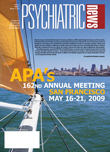The decades-long struggle to reduce the ease with which people can commit suicide by leaping from the Golden Gate Bridge resulted in an agreement by government officials late last year to erect a preventive impediment.
The bridge directors took the historic step in October 2008 of approving the first permanent suicide deterrent—suspended steel nets about 20 feet below the bridge's sidewalks. This will be the only physical impediment other than the bridge's four-foot-high railing.
The net's approval followed a five-year public-awareness and lobbying effort by the Psychiatric Foundation of Northern California's Golden Gate Bridge Suicide Barrier Task Force, other mental health advocates, and families of people who committed suicide at the bridge.
“There is a lot of ignorance about suicide, even in this liberal area,” task force chair Mel Blaustein, M.D., told Psychiatric News.
The task force initially worked to educate the public that suicide is a crisis-driven action and that the mental illness that makes suicide seem desirable can be treated successfully. The task force–led effort was the eighth campaign to build a suicide barrier at the bridge, which currently depends on cameras and roving foot patrols to prevent people from jumping.
Advocates insisted that existing measures have proven insuffient to eliminate the bridge suicides, which numbered at least 34 in 2008, according to estimates released in January by the Marin County coroner. There have been more than 1,300 suicides since the bridge opened in 1937.
The task force's education campaign addressed the misconception by many that a barrier is pointless because a suicidal person would only end his or her life through another means. Others objected to structure that would interfere with the bridge's appearance.
Barrier advocates pointed out that the bridge's iconic status has drawn people to end their lives there, many of whom might otherwise have been able to get help for their emotional crisis. Survivors of bridge jumps have said that they immediately regretted their decisions as soon as they leapt from the bridge.
“There has been a real change in the thinking of the bridge directors in recent years,” Blaustein said.
The remaining obstacle to installing the net is how the bridge managers will fund it—costs are estimated at up to $50 million.
Education efforts regarding Golden Gate Bridge suicides will continue at APA's annual meeting with Blaustein moderating a discussion titled“ Suicide and the Golden Gate Bridge” and a showing of the documentary film “The Bridge,” which chronicles suicides there in 2004 through continuous filming of the bridge. The session will be held on Wednesday, May 20, at 9 a.m.
Information on the Golden Gate Bridge Suicide Barrier Task Force is posted at<www.pfnc.org/bridge/index.aspx>.
